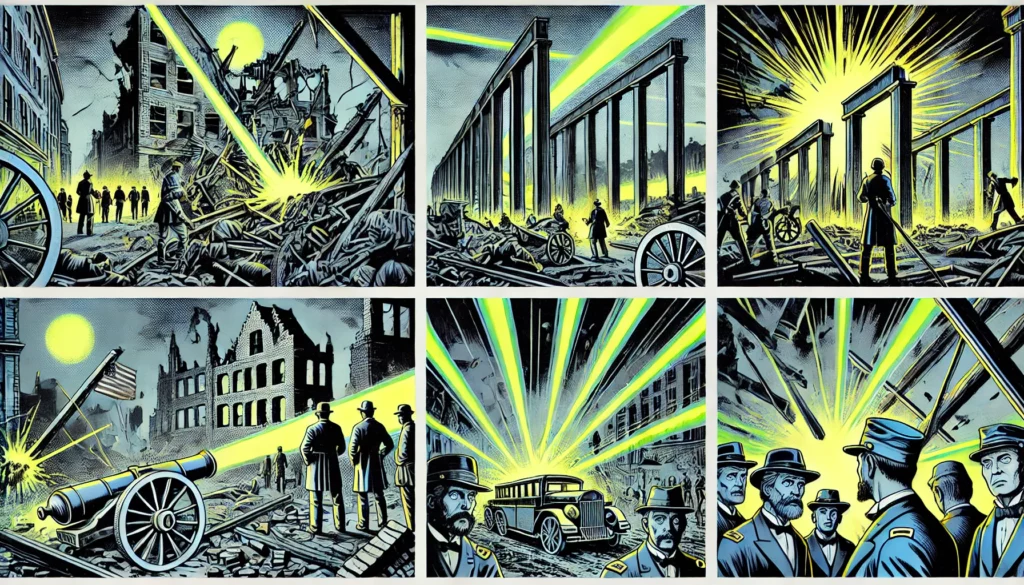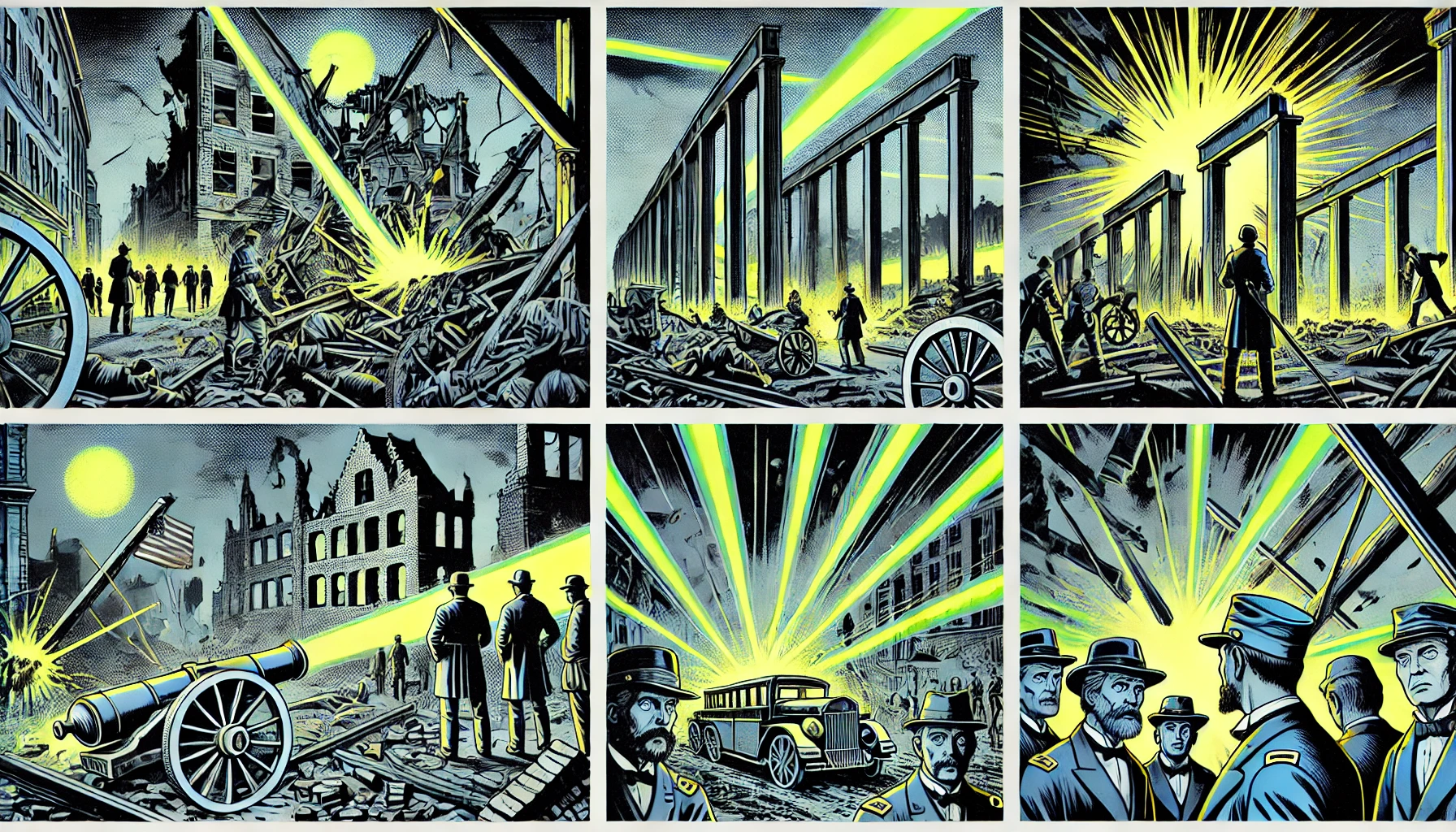Reconsidering the American Civil War as having involved Directed Energy Weapons
Directed Energy Weapons and the American Civil War: The Only Plausible Explanation for the Inexplicable
The official narrative of the American Civil War relies on 19th-century conventional warfare—muskets, cannonballs, and horse-drawn supply chains—to explain the conflict that ravaged cities, fields, and fortifications. However, when we analyze the hard evidence (or lack thereof), glaring inconsistencies emerge that traditional explanations fail to reconcile. The total absence of spent cannonballs amid rubble, the suspiciously uniform distribution of destroyed materials, and the fundamental logistical impossibility of the war effort all point to one conclusion: Directed Energy Weapons (DEWs) were responsible for much of the devastation attributed to conventional artillery.
1. The Complete Absence of Spent Cannonballs in Ruins
A simple review of Civil War-era battlefield photography reveals a stunning omission: there are no images showing spent cannonballs lying amidst the rubble they supposedly caused. Given the scale of bombardments that reportedly reduced structures to ruins, we should expect to see thousands of cannonballs—damaged, embedded, or otherwise present—scattered throughout the destruction. Instead, not a single photograph contains such evidence.
- Logical Consequence: If cannonballs were the primary cause of devastation, some would have remained in place post-impact, whether intact or fragmented. Their absence suggests that the destruction was caused by another force—one that left no traditional artillery remnants behind.
2. The Too-Uniform Spread of Rubble
Analysis of Civil War destruction photographs shows another anomaly: the rubble is suspiciously uniform, lacking the uneven impact patterns expected from kinetic bombardment. Cannon fire, by its nature, creates highly irregular destruction, with debris scattered in unpredictable trajectories based on velocity, impact angles, and structural composition. Instead, many Civil War ruin sites feature:
- Evenly distributed debris fields that do not align with the expected physics of explosive artillery.
- Structures reduced to powder and fine rubble, inconsistent with the large, jagged remains seen in conventional explosive demolition.
- Buildings entirely vaporized or gutted, leaving only skeletal frameworks, akin to modern high-energy weapon damage.
- Logical Consequence: The destruction patterns more closely resemble effects associated with high-energy directed weaponry rather than cannonball bombardment.
3. The Impossibility of a Horse-Drawn Artillery Supply Chain
The Civil War occurred in an era lacking mechanized logistics. Official history claims that hundreds of thousands of heavy artillery shells and cannonballs were manufactured, transported, and used in combat across vast distances—all by horse-drawn wagons, boats, and rail systems that lacked industrial efficiency. The problems with this claim are insurmountable:
- Material Shortages: Producing and distributing such massive quantities of iron and explosives should have required an industrial supply chain that simply did not exist at scale.
- Weight and Transportation Constraints: A single large-caliber cannonball weighed 10–50 pounds. Moving and supplying thousands of such rounds across rough terrain by horse and manpower alone is implausible.
- Total Lack of Cannonball Stockpiles: Despite supposed mass-production, we see virtually no surviving examples of collected or stockpiled artillery.
- Logical Consequence: The destruction witnessed cannot be explained by conventional artillery logistics. Instead, the possibility arises that a different, more advanced form of weaponry was used, one that required no heavy munitions at all—Directed Energy Weapons.
4. The Near-Complete Absence of Photographs Taken During Battle
One of the most conspicuous anomalies of the Civil War is the lack of battle-action photographs. While technological limitations are often cited as an excuse (such as long exposure times), consider the following:
- By the 1860s, photography had advanced enough to capture sharp images of moving objects under the right conditions. Yet not a single known photograph shows an active battlefield, only staged post-battle scenes.
- The war was extensively documented, with thousands of photographs taken. If active battle photography was truly impossible, why do we see numerous well-composed images of war preparation, encampments, and aftermaths, but none depicting the act of combat itself?
- Censorship or evidence suppression? Given the deliberate lack of battle-action images, it is reasonable to ask whether such photographs were either destroyed or never allowed to exist in the first place.
- Logical Consequence: The absence of battlefield images suggests something was occurring that could not be documented—possibly the use of a technology incompatible with the 19th-century warfare narrative.
Conclusion: DEWs Offer the Only Viable Explanation
Taken together, these anomalies form a clear pattern:
- The lack of spent cannonballs amidst destruction indicates that kinetic projectiles were not responsible for much of the devastation.
- The too-even rubble distribution mirrors the effects of high-energy, non-kinetic weapons rather than impact-based explosions.
- The logistical impossibility of a purely horse-powered artillery supply chain undermines the idea that conventional munitions could have sustained such widespread destruction.
- The complete lack of active battle photographs suggests suppression of evidence and hints at an unseen technological element in the conflict.
Given these facts, the most reasonable explanation is that the American Civil War saw the use of directed energy weapons—technology far beyond what the official record acknowledges. If such weapons were indeed deployed, the implications are vast: history as we know it has been rewritten to obscure the true nature of the war, its means of destruction, and the suppressed technology that played a role in shaping modern warfare.
Further Investigation
To expand this research, we must:
- Analyze Civil War-era photographs for telltale signatures of directed energy damage.
- Cross-examine historical records on munitions manufacturing and artillery deployment.
- Investigate possible 19th-century experimental technologies that could have been precursors to modern directed energy systems.
The evidence suggests that the American Civil War, much like certain modern conflicts, may have involved technology far beyond what the mainstream narrative is willing to acknowledge. The question is not whether DEWs were involved—but rather, who was using them, and why their existence has been erased from history.

